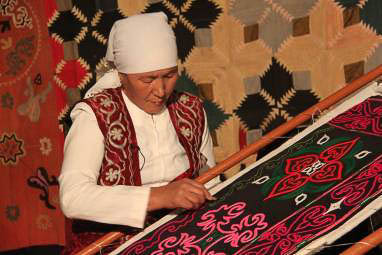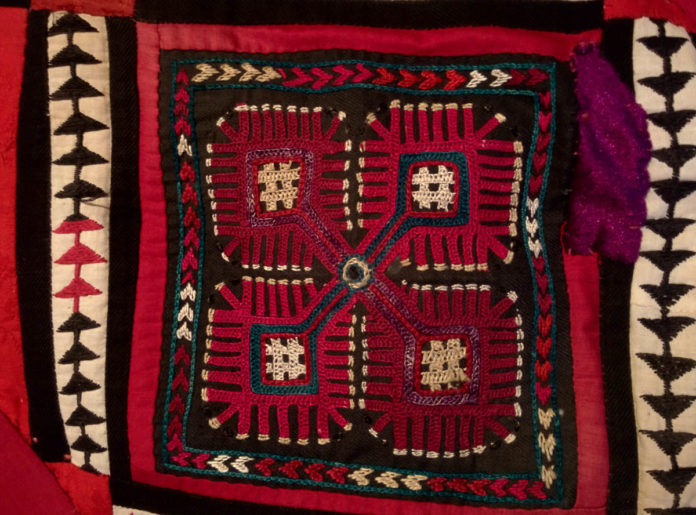Embroidery was a very popular and widespread type of needlework that was practiced by Kyrgyz women of all ages, from young to old. This kind of needlework in comparison with other traditional crafts was more individualistic.
Embroidery decorated clothes and headgear, bedspreads, curtains, pillows and other interior items, bags, blankets, pouches, kitchen utensils, etc. Kyrgyz masters embroidered using cotton, wool or silk threads of different colours various fabrics including velvet, cotton, wool fabric as well as felt, leather and suede. Most frequently used stitching include tambour (ilme), smooth (basma), loop edge seam and chyrash stitch. At the end of the nineteenth century, under the influence of Russian embroidery, cross-stitch on white cotton fabric became widespread.
The embroidery ornaments echo times when people were inspired by surrounding nature, depicting sun and moon, symbols of life and fertility. Often there are plant and animal ornamental motifs used in embroidery, also used in other handicraft techniques, such as: anar (pomegranate), badam (almond), kochkor muyuz (horn of a ram); karga tirmak (the crow claws); kush kanat (a bird in flight); chymyn kanat (wings of a fly), tumarcha (an amulet). Common for embroidery are figures in the form of a spider (zhergemyush); zigzag lines (iyrek) and dotted lines (sekirtme).

Among the ornament sometimes there are stylized images of animals and birds. By their conventionally simplified outlines, they resemble images of animals and birds on metal products of the Yenisei Kyrgyz of the ninth to eleventh centuries. At the end of the nineteenth century, rooster images became widespread, imitating the patterns of Russian and Ukrainian embroidery.
For the traditional embroidery ornament, local colours are inherent, without the use of their shades. The system of semantic values of colours developed for centuries reflects the national mindset. The most common colour in ornamental compositions of embroidery is red. It’s the colour of life, love and festivity. Green, white, yellow and blue colours are also among most favourites. Black colour was rare, mostly used for the outline.
One of the best examples of embroidery art is tush-kiiz wall hanging, widespread throughout Kyrgyzstan. Back in the nineteenth century, craftsmen made tush-kiiz from felt decorating it with red cloth appliqués or embroidering it with dyed wool. Tush-kiiz has a rectangular shape, stretched in width, framed by a wide embroidered edge on top and two sides. The basis for embroidery is a dark woollen or cotton fabric, sometimes velvet. The middle, non-stitched part of tush-kiiz was made of bright silk, less often of velvet, plush and brocade. Transversal part of the embroidered edge usually had one, two or three descending embroidered triangles attached called tumarcha.
In the north of the country, tush-kiiz were crocheted on fabrics that were stretched over the frame, while in the south the embroidered fabric was pinned on a woman’s dress, stretched over a bent knee so that she could work sitting on the floor. Seams used included ilme, sekirtme, ilmedos and basma. Tush-kiiz was always embroidered by a woman as a gift to her son or daughter and represented the sacred memory of a mother within a family. Each tush-kiiz was unique, there was not a single one that exactly duplicated another piece.
Currently, in Kyrgyzstan, hand embroidery is used mostly in the expensive dress for special occasions. Almost no one is engaged in tush-kiyiz hand embroidery. Artist-designer Iresh Gulzhan and some other craftsmen are trying to revive this ancient art.





